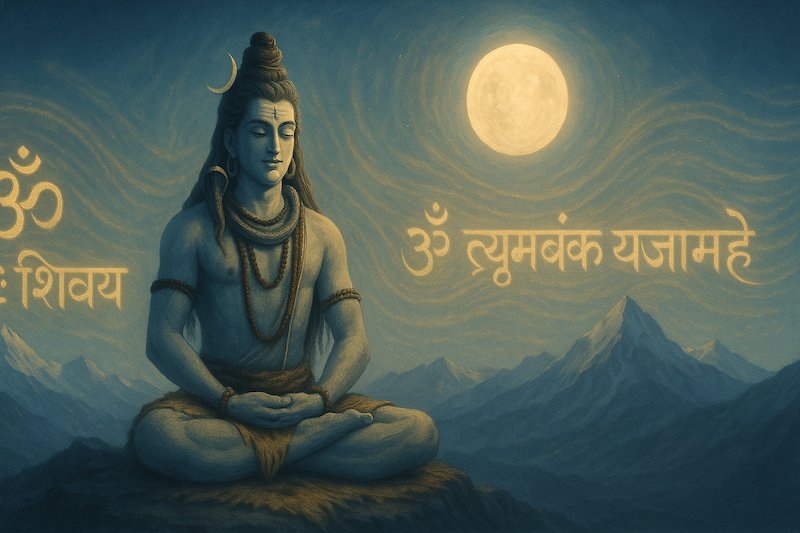Most Powerful Shiva Chants from the Scriptures

Explore the most revered Shiva chants from the Vedas, Puranas, and stotras — their meanings, origins, and how to use them in daily practice for peace and devotion.
Lord Shiva, the eternal yogi and destroyer of ignorance, is adored through countless hymns, mantras, and chants preserved in the Vedas, Puranas, and works of great saints. These chants not only invoke blessings but also help calm the mind, awaken inner strength, and deepen spiritual connection.
Here are some of the most well-known Shiva chants from the scriptures that continue to resonate with devotees worldwide.
1. Panchakshari Mantra (ॐ नमः शिवाय)
-
Source: Yajur Veda
-
Text: Om Namah Shivaya
-
Meaning: “I bow to Lord Shiva.”
-
Known as the five-syllable mantra (Pancha Akshara), this is the most sacred and simple chant of Shiva. Repeating it brings inner peace, dissolves ego, and aligns the soul with divine consciousness.
2. Mahamrityunjaya Mantra
-
Source: Rig Veda (7.59.12)
-
Text (transliterated):
Om Tryambakam Yajamahe Sugandhim Pushtivardhanam |
Urvarukamiva Bandhanan Mrityor Mukshiya Maamritat || -
Meaning: “We worship the three-eyed Lord Shiva who nourishes all beings. May He liberate us from the bondage of worldly attachments and death, granting us immortality.”
-
Often called the conqueror of death mantra, it is recited for healing, protection, and overcoming fear.
3. Rudram (Sri Rudraprasna)
-
Source: Krishna Yajur Veda (Taittiriya Samhita)
-
Opening line: Om Namo Bhagavate Rudraya
-
The Sri Rudram is a Vedic hymn glorifying Shiva in his fierce and benevolent forms. It is central to Rudrabhishekam rituals and is believed to purify karmas and bestow divine grace.
4. Lingashtakam
-
Source: Traditional stotra, recited in temples
-
Opening verse: Brahma Murari Surarchita Lingam…
-
This hymn praises the Shiva Linga as the symbol of cosmic creation and dissolution. Devotees chant it during daily worship and special festivals like Maha Shivaratri.
5. Shiva Tandava Stotram
-
Attributed to: Ravana (as mentioned in the Shiva Purana)
-
This powerful chant describes Lord Shiva’s cosmic dance (Tandava). Its rhythmic verses are filled with energy and devotion, symbolizing the cycle of creation and destruction.
6. Shivananda Lahari
-
Author: Adi Shankaracharya
-
A devotional hymn of 100 verses expressing total surrender, love, and joy in worshipping Lord Shiva. Unlike the more formal Vedic chants, this one is deeply personal and emotional.
7. Bilvashtakam
-
Source: Shiva Purana
-
Theme: Praises the offering of bilva leaves to Lord Shiva, considering it one of the most sacred acts of devotion. Each verse highlights the spiritual merit of this offering.
How to Use These Chants in Practice
-
Daily Practice: Simple mantras like Om Namah Shivaya can be chanted anywhere, anytime.
-
Meditation: Reciting the Mahamrityunjaya Mantra with focus brings calm and healing.
-
Temple Worship: Longer stotras like Lingashtakam or Rudram are best chanted during puja or rituals.
-
During Girivalam or Pilgrimage: Short and powerful chants (like Panchakshari) help maintain focus and devotion during the walk.
Conclusion
Shiva chants are more than words — they are vibrations that connect the devotee to the infinite. Whether you chant the simple Om Namah Shivaya or immerse in the depth of Rudram, each mantra carries the power to cleanse the heart, strengthen the mind, and awaken the soul.
As the scriptures remind us, even a single heartfelt chant of Shiva’s name can open the doors to liberation.
